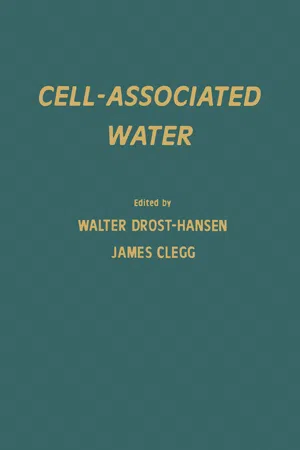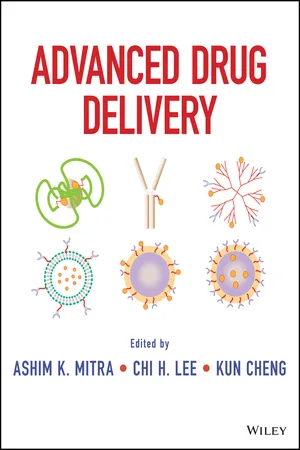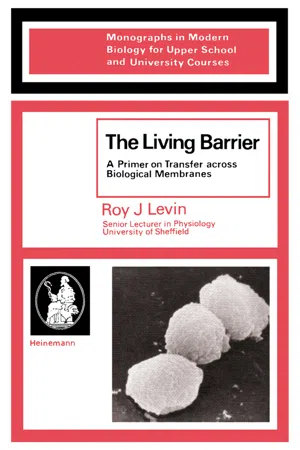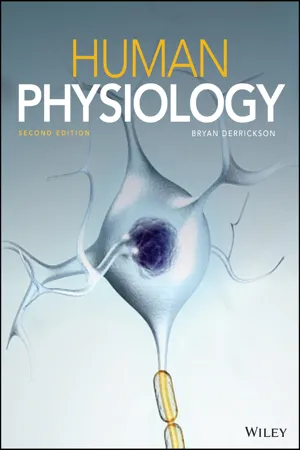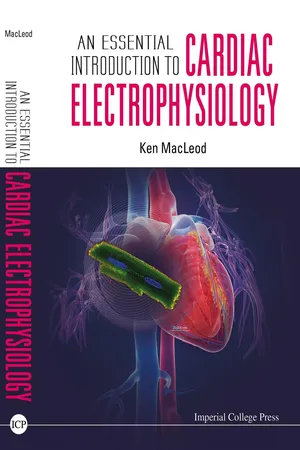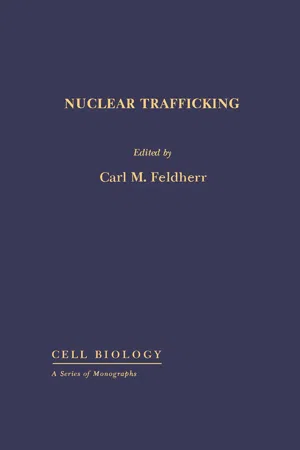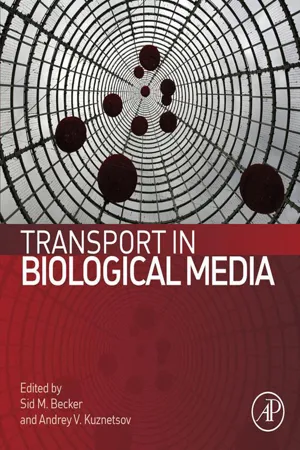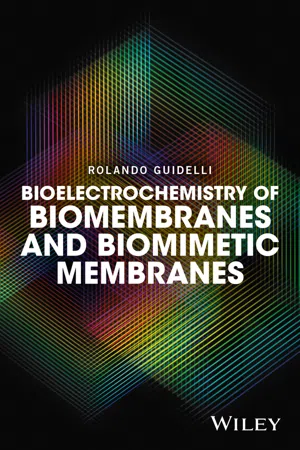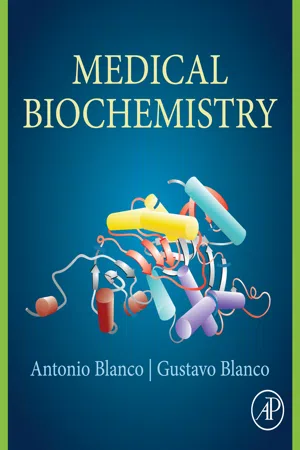Biological Sciences
Active Transport
Active transport is a process in which cells use energy to move molecules or ions across a cell membrane against their concentration gradient. This allows the cell to accumulate substances that are in low concentration outside the cell. Active transport is essential for maintaining proper cellular function and is carried out by specific transport proteins embedded in the cell membrane.
Written by Perlego with AI-assistance
Related key terms
1 of 5
12 Key excerpts on "Active Transport"
- eBook - PDF
Cell-Associated Water
Proceedings of a Workshop on Cell-Associated Water Held in Boston, Massachusetts, September, 1976
- W. Drost-Hansen, James S. Clegg, W. Drost-Hansen, James S. Clegg(Authors)
- 2013(Publication Date)
- Academic Press(Publisher)
Cell-Associated Water METABOLIC CONTROL OF THE PROPERTIES OF INTRACELLULAR WATER AS A UNIVERSAL DRIVING FORCE FOR Active Transport^ Philippa M. Wiggins Department of Medicine University of Auckland School of Medicine Auckland, New Zealand I. INTRODUCTION Over the last few years an attempt has been made to de-velop an hypothesis of energy conservation as adenosinetri-phosphate (ATP), and its use for Active Transport, which is simple, universal and yet sufficiently versatile to be able to account for the wide diversity of transport processes. The hypothesis ascribes to water a central role in many cellular processes, and requires that both its structure and its solvent properties be under some degree of metabolic control (1,2,3). Active Transport is defined initially as an energy-dependent movement of an ion (or other solute) against a real or apparent electrochemical potential gradient. For example, most cells loaded with Na* will, in the presence of energy, expel Na* ions against a concentration gradient until a steady state is reached. In the case of muscle, for example, the apparent concentration of intracellular Na^ is about 25 Mole · m^, and that of extracellular Na* about 145 Mole · m^, while the potential difference across the mem-brane is -90 mV (inside negative relative to outside). In the absence of energy, on the other hand, muscle cells ^This work was carried out during the tenure of a Career Fellowship of the Medical Research Council of New Zealand. Copyright © 1979 by Academic Press, Inc. All rights of reproduction in any form reserved. ISBN 0-12-222250-4 jQ Philippa Μ. Wiggins continue to take up Na* until the intracellular concentra-tion is higher than the extracellular concentration, and the membrane potential is quite low, but still negative in-side relative to outside. - eBook - PDF
- David C. Venerus, Hans Christian Öttinger(Authors)
- 2018(Publication Date)
- Cambridge University Press(Publisher)
24 Transport in Biological Systems Life depends on transport. In this chapter, we discuss molecular motors and ion pumps, which perform key functions in living organisms. Both examples of molecular machines are based on activated transport, that is, transport enabled by the energy provided by a chemical reaction, typically the hydrol-ysis of adenosine triphosphate (ATP). Molecular motors convert chemical energy into mechanical work (such as locomotion, carrying around stuff in cells); ion pumps transport ions against concentration gradients. In both cases, our goal is to develop kinetic theories to predict phenomenological transport coefficients from more microscopic descriptions. Both kinetic the-ories are based on stochastic equations. For ion pumps, we rely on a diffusion equation introduced in Chapter 2 and repeatedly occurring ever since. For molecular motors, we rely on a master equation as a useful new tool. 24.1 Molecular Motors Purposeful movement is one of the characteristics of living organisms. This ability is based on molecular motors that convert chemical into mechani-cal energy. Indeed, molecular motors are the key to Active Transport , which keeps living organisms away from deadly equilibrium. Our description and modeling of such tiny machines is strongly influenced by Chapter 16 of the comprehensive textbook entitled Physical Biology of the Cell by Phillips, Kondev, and Theriot. 1 Transport of ions through cell membranes against ion concentration gra-dients, already mentioned for motivation in Section 1.1 , provides an example of Active Transport. Even large molecules, such as proteins, nucleic acids, sug-ars, or lipids, can be pushed or pulled through holes in membranes, which is typically achieved by translocation motors . In the present chapter, however, 1 Phillips et al ., Physical Biology of the Cell (Garland Science, 2009). 416 Transport in Biological Systems we rather focus on translational motors . - eBook - ePub
- Ashim Mitra, Chi H. Lee, Kun Cheng(Authors)
- 2013(Publication Date)
- Wiley(Publisher)
Active Transport results in the accumulation of a solute on one side of the membrane and often against its electrochemical gradient. It occurs only when solute accumulation is coupled with the exergonic process directly or indirectly [4]. During the transport process, energy sources, such as adenosine triiphosphate (ATP), electron transport, or an electrochemical gradient of another ion, are used to drive ions or molecules against their electrochemical potential gradients [4]. The Active Transport process maintains membrane potential and ion gradients, storage of energy for secondary transporters, and pH regulation inside the cell [4].In primary Active Transport, solute accumulation is directly coupled with the exergonic reaction (conversion of ATP to adenosine triiphosphate (ADP) + Pi) [4]. Secondary Active Transport occurs when uphill transport of one solute is coupled with the downhill flow of another solute that was originally pumped uphill flow by primary Active Transport.An example of the primary Active Transporter is the Na+ K+ ATPase in the mammalian cells that is energized by ATP [4]. Animal cells maintain a lower concentration of Na+ and a higher concentration of K+ intracellularly than are found in extracellular fluid. This concentration difference is established and maintained by primary Active Transport systems in the plasma membrane. The process is mediated by the enzyme Na+ K+ ATPase that couples the breakdown of ATP with the simultaneous and electrogenic movements of both Na+ and K+ against their concentration gradients (i.e., three Na+ ions move outward for every two K+ ions that move inward) [4].In animal cells, the differences in cytosolic and extracellular concentrations of Na+ and K+ are maintained by Active Transport via Na+ K+ ATPase, and the generated Na+ gradient is used as an energy source by a variety of symport and antiport systems [4]. The Na+ K+ ATPase shows specific distribution patterns on the animal cell surface. A few primary Active Transporters, such as MDR1, MRP2, MRP4, and BCRP in the epithelial membrane, and MRP1, MRP3, MRP4, and MRP5 in the basolateral membrane, are shown in Figure 1.1 - eBook - PDF
The Living Barrier
A Primer on Transfer across Biological Membranes
- Roy J. Levin(Author)
- 2013(Publication Date)
- Butterworth-Heinemann(Publisher)
For non-electrolytes, active transfer occurs when the substance is moved uphill against its concentration gradient. When we come to substances that have a charge on them like ions, amino acids or fatty acids, we have to be sure that they are not only pumped against their concentration gradient but also against their electrochemical gradient. Obviously if a membrane is polarized so that one side is negative and the other positive, ions and other charged substances The Movement of Molecules Across Cell Membranes 79 with a net positive charge will move through the membrane and collect on the negatively charged side and vice versa. The charged substances may accumulate to a much higher concentration than that on the other side. There is thus a danger of saying that these substances are actively transferred by biological pumps. Our definition of active movement as transfer against the electrochemi-cal concentration gradient excludes such a mechanism. Two other processes can bring about transfer of non-electrolytes against a concentration gradient without there being genuine active transfer. If a carrier mediates the transfer of two substances with different affinities for the carrier the interaction between their movement on the carrier can cause one of the substances to be transferred against its concentration gradient. This is especially so if the other substance is moving down its concentration gradient, via the carrier. The energy from this downhill movement can power the uphill movement of the other. This process is known as in-duced counterflow. It is also known that the active transfer of one solute can induce the apparent active transfer of another (primary active transfer inducing secondary active transfer). This is thought to happen in the mucosal cells of the small intestine. The pumping of sodium out of the cell by active transfer is thought to be intimately linked with the cell's ability to concentrate glucose and other sugars. - eBook - PDF
- Bryan H. Derrickson(Author)
- 2019(Publication Date)
- Wiley(Publisher)
Active Transport of solutes is mediated by carrier proteins. Like carrier-mediated facilitated diffusion, Active Transport exhibits specificity, affinity, saturation, and competition. For a carrier protein that medi- ates Active Transport, the binding site has a high affinity for sol- ute when the binding site faces the low-concentration side of the membrane and has a low affinity for solute when the bind- ing site faces the high-concentration side of the membrane. This is in contrast to a carrier protein that mediates facilitated diffusion, in which the affinity of the binding site for solute is the same on either side of the membrane. Solutes actively transported across the plasma membrane include several ions, such as Na + , K + , H + , Ca 2+ , I − (iodide), and Cl − ; amino acids; and monosaccharides. (Note that some of these substances also cross the membrane via facilitated diffusion when the proper channel proteins or carriers are present.) Primary Active Transport Uses Energy from ATP to Move a Solute Against Its Gradient In primary Active Transport, energy derived from hydrolysis of ATP changes the shape of a carrier protein, which pumps a sol- ute across a plasma membrane against its concentration or electrochemical gradient. Indeed, carrier proteins that mediate primary Active Transport are often called pumps. A typical body cell expends about 40% of the ATP it generates on primary Active Transport. Chemicals that turn off ATP production—for example, the poison cyanide—are lethal because they shut down Active Transport in cells throughout the body. The most prevalent primary Active Transport mechanism expels sodium ions (Na + ) from cells and brings potassium ions 146 CHAPTER 5 Transport Across the Plasma Membrane Na + electrochemical gradient to move a solute against its concentration gradient from extracellular fluid to the cytosol (Figure 5.17): 1 A Na + ion binds to a Na + binding site on the extracellular side of the carrier protein. - Ken MacLeod(Author)
- 2013(Publication Date)
- ICP(Publisher)
Chapter 5Active TransportersWe have learnt from previous chapters that channel opening allows a particular ion to diffuse across the membrane according to its electrochemical gradient. If this ion movement is not counteracted in some way, the concentration differences across the cell membrane will slowly dissipate and cell excitability will gradually be lost. Cells maintain the chemical gradients upon which the ionic movement depends by using another group of membrane transport proteins known collectively as Active Transporters.5.1Chapter objectives
After reading this chapter you should be able to: •List and compare the properties of Active Transporters with those of channels•Describe the structure and function of the Na+ /K+ ATPase, the Na+ /Ca2+ exchanger and the Na+ /H+ exchanger•Discuss how the intracellular concentrations of Na+ , H+ and Ca2+ are regulated and why the concentration of one of these ions plays a role in determining the concentration of the others5.2What do Active Transporters do?
These proteins move ions (and some amino acids and sugars) against their electrochemical gradients by forming complexes with them and then changing their conformation to deliver the ion on the other side of the membrane. The processes of ion binding, conformational switching and then unbinding are much slower than moving an ion through a channel. There are different types of Active Transporter largely categorized on whether or not they use ATP as an energy source.To move ions against their concentration gradient requires some form of energy input. Some transporters use the energy derived from the hydrolysis of ATP and these are called ATPases or pumps. Other transporters do not use ATP but, instead, use the large electrochemical gradients of some ions as an energy source. The movement of one ion against its concentration (and/or electrical) gradient is coupled to the transport of another ion down- eBook - PDF
- Carl Feldherr(Author)
- 2012(Publication Date)
- Academic Press(Publisher)
Clearly, Active Transport mechanisms, that is, moving a substance against its chemical gradient, would be dependent on coupling to the decrease in free energy of some metabolic process. In general, energy coupling to any of the four steps in the cyclic-process carrier-type envelope transport mechanisms would be both sufficient and feasible. However, as mentioned previously, a re-quirement for ATP hydrolysis does not itself constitute proof that active trans-port is occurring. For example, facilitated diffusion of large molecules, in particular those with diameters > 90-100 Â, through the NPC requires an energy source to elicit requisite conformational changes in the transportant and/or NPC proteins. Finally, one or more energy-requiring steps may be needed to process a molecule or its receptor(s), even when energy is not used to drive envelope transport per se. For instance, nuclear accumulation follow-ing envelope transit could require ATP hydrolysis if intranuclear retention by association is energy dependent. Rapid ATP-dependent intranuclear degrada-tion of specific proteins could result in continuous nuclear influx by simple diffusion. There are two general types of coupling: primary and secondary. Primary Active Transport uses the direct coupling of an energy-producing reaction, such as nucleo-side triphosphate hydrolysis, to drive transport. This transport may involve a conformational change of a protein carrier or channel. Alternatively, a group translocation may operate in which energy is used to covalently bind a chemical group such as a phosphate to the transportant. The group may be released with a decrease in free energy some time after transport. A rapidly increasing body of evidence implicates reversible phosphorylation/dephosphorylation in the nuclear accumulation of specific N-proteins. Secondary Active Transport couples the active uphill transport of one sub-stance to the downhill transport of a second, the driver. - S. C. Skoryna, D. Waldron-Edward, S. C. Skoryna, D. Waldron-Edward(Authors)
- 2013(Publication Date)
- Pergamon(Publisher)
It is evident that in any animal cell which subserves the function of translocation, the occurrence of some form of cytoplasmic streaming will transport and stir intracellular substrate. Although the occurrence of any orderly movement of the intracellular contents will require the expen-diture of energy and must ultimately add to the metabolic cost of translocation, Ewart has calculated that the energy expended in sustaining protoplasmic streaming must be relatively small. (48) The occurrence of such a process in absorbing cells would serve as yet another example of the wide and fascinating variety of phenomena which challenge workers in the fields of biological transport and intestinal absorption. The response of the investigator to this challenge is to direct his thoughts, ingenuity and efforts towards devising experimental procedures to test his views of the phenomenon. At least one outcome of such experiments can be predicted; many more problems will arise, each yet another challenge to the inves-tigator. Summary 1. A description is given of the properties of some model systems for the transcellular Active Transport ('translocation') of material across a single layer of epithelial cells. 2. The functioning of the models depends upon the occurrence of solute ('substrate') pumping across the bordering membranes of a unit cell, the membranes being also leaky to the substrate. Two types of system are specified. In one sort the limiting membranes of the unit cell are furnished with 'pumps' which move substrate into the cell so that the intra-cellular electrochemical potential of the substrate is maintained at a value greater than that outside and translocation is achieved by the movement of substrate passively out of the cell down leaks.- eBook - ePub
- Sid M. Becker, Andrey V. Kuznetsov, Sid Becker, Andrey Kuznetsov(Authors)
- 2013(Publication Date)
- Elsevier(Publisher)
Chapter 5Carrier-Mediated Transport Through Biomembranes
Ranjan K. Pradhan, Kalyan C. Vinnakota, Daniel A. Beard and Ranjan K. Dash, Biotechnology and Bioengineering Center and Department of Physiology, Medical College of Wisconsin, Milwaukee, WI, USAAcknowledgment
This work was partially supported by the National Institute of Health grants R01-HL095122 (RKD) and P50-GM094503 (DAB).5.1 Introduction
Biological membranes are composed of phospholipid bilayers, which act as a selective barrier within or around a cell [1] . Transporters or carriers are specialized proteins spanning the phospholipid bilayer that facilitate the translocation of ions, metabolites and macromolecules across the membrane. Transport processes are usually classified as active (primary or secondary) or passive transport [2] . Primary Active Transport involves the movement of a solute against its electrochemical gradient facilitated by coupling to a process that provides the required free energy, e.g., pump driven by ATP hydrolysis, whereas passive transport is always driven by the solute electrochemical gradient. Secondary Active Transport is also commonly known as ion-coupled solute transport, and is where the electrochemical gradient of an ion maintained by an Active Transport process is utilized to transport a different solute. This is another commonly observed mode of transport in biological membrane systems (e.g., -glucose cotransporter [3] , -monocarboxylate cotransporter [4] and exchanger [5] - Wes Stein(Author)
- 2012(Publication Date)
- Academic Press(Publisher)
C H A P T E R 6 The Primary Active Transport Systems 6.1 Criteria for Distinguishing between Primary and Secondary Active Transport Systems A simple yet sufficient criterion of the existence of an Active Transport system is that the following condition b e satisfied: A net flux of the permeant must occur in a direction opposite to that of the electrochemical gradient of the transferred species (Section 2 . 7 ) . In Chapter 5 w e saw that many Active Transports arise as a result of the co-transport of a metabolite together with sodium ions. T h e linking of the fluxes of the metabolite and the sodium ions results from the requirement that both these species must be attached to the mobile membrane carrier if transport is to occur. Thus the force driving the flux of sodium ions (the electrochemical gradient of sodium) indirectly drives by co-transport the flux of metabolite. W e have seen, too (Section 5 . 5 ) , that by counter-transport the Active Transport of a third species can b e linked by two stages with the electrochemical gradient of sodium ions. It is conceivable that all Active Transport in a cell might occur by such secondary and tertiary transports, the fundamental concentration gradient arising per-haps from the continual intracellular depletion of some cell constituent by metabolic activity. L e t us consider how we could distinguish between this situation and a true case of primary transport. W e begin by considering the possible forces that can drive a net flux. In Section 2.8 we saw how it was possible to consider Ji the flux of the ith component as resulting from ( 1 ) the electrochemical gradient in i i t s e l f : — Δ /Λ ί? · or ( 2 ) an interaction with the flux J } of some other com-ponent or ( 3 ) the action of some chemical reaction J r . Formally, we can write η Ji = Ra Αμΐ + ^RijJj + RirJr (6 -1) .7 = 0 207 208 6. THE PRIMARY Active Transport SYSTEMS where the interaction coefficients are the respective terms R.- Rolando Guidelli(Author)
- 2016(Publication Date)
- Wiley(Publisher)
129 5 Active Transport 5.1 The Ion Pumps Only a limited number of integral proteins, called ion pumps, have the ability to couple an exergonic chemical or photochemical reaction to a flow of ions across a membrane against their electrochemical potential gradient. This coupling of a scalar process (the chemical or photochemical reaction) to a vectorial process (the ion translocation) can only take place in a heterogeneous system provided by a biological membrane interposed between its interior and exterior solutions. Only some inorganic ions, such as Na + , K + , Ca 2 + , and H + , are translocated specifically by the ion pumps. Ion pumps can be subdivided into three classes: (i) ATPases; (ii) enzymes of the electron-transport chain, which translocate protons; and (iii) light-driven proton pumps, such as bacteriorhodopsin (Läuger, 1991). ATPases are integral membrane proteins that couple the exergonic reaction of hydrolysis of ATP into ADP and free phosphate ion (P i ) to the endergonic trans-port of an ion across a membrane against its electrochemical potential gradient. This coupling is widely used in all known forms of life. There are different types of ATPases, which differ in function (ATP synthesis and/or hydrolysis), structure, and type of transported ion. They can be classified into P-type, F-type, V-type, and A-type ATPases. P-type ATPases, also known as E 1 –E 2 ATPases, are a large group of evolution-arily related ion pumps that are found in bacteria, archaea, and eukaryotes. They are referred to as P-type ATPases because they catalyze phosphorylation of a key conserved aspartate residue within the pump by ATP. Vanadate, a transition-state analog of phosphate, inhibits this reaction, since it competes with phosphate for the specific binding site in the ion pump, preventing its phosphorylation.- No longer available |Learn more
- Gustavo Blanco, Antonio Blanco(Authors)
- 2017(Publication Date)
- Academic Press(Publisher)
Active Transport , requires energy input, which in most cases comes from the hydrolysis of ATP.Passive transport or facilitated diffusion
Unlike simple diffusion, facilitated diffusion exhibits specificity and saturability. The carriers form a carrier–solute complex that is similar to the enzyme–substrate complex. In facilitated transport (and also in Active Transport) the flow rate versus the solute concentration can be described by a hyperbolic curve (Fig. 11.8 ). This curve follows the one seen in Michaelis–Menten kinetics, which depicts enzyme activity as a function of substrate concentration (Fig. 8.5 ). The relationship between the flow rate and solute concentration indicates that the process is saturable. When all of the carriers in the membrane are filled with solute, maximum flow is attained and does not further increase, even when the solute concentration increases.Figure 11.8 Graphic representation of the flow rate depending on the concentration of solute in a facilitated diffusion process (same type of curve is obtained for Active Transport). The curve is a hyperbola (Michaelis–Menten kinetics).A constant, K m or K 0.5 , corresponds to the solute concentration at which half the maximum flow rate is reached. In almost all cases, the K m value is inversely related to the affinity of the carrier for the solute. The lower the K m
Index pages curate the most relevant extracts from our library of academic textbooks. They’ve been created using an in-house natural language model (NLM), each adding context and meaning to key research topics.
